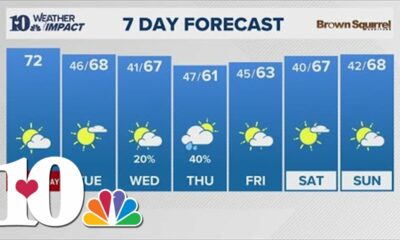Kaiser Health News
Dads Drive Growth in California’s Paid Family Leave Program
Phillip Reese
Mon, 30 Oct 2023 09:00:00 +0000
In a sign of growing domestic equality, more new dads are claiming paid family leave to bond with their babies and support their partners during the first weeks of parenthood. In California, which has one of the nation’s oldest programs, men filed 44% of bonding claims last year, up from 31% a decade prior, according to state statistics.
About 119,300 California men took paid family leave for bonding in the state’s fiscal year that ended at the end of June, up by 19%, or nearly 20,000, from 2020, according to California’s Employment Development Department. The number of women taking state leave for bonding has held relatively steady at roughly 150,000 since 2019.
Not only are a new generation of fathers more likely to embrace taking time off to build a connection with their children, but more employers have normalized leaves for their male workers. Those attitudes, experts said, were strengthened during the pandemic, when many men worked from home as their children learned remotely or played nearby.
“If you have a male co-worker who takes paternity leave, you’re more likely to take paternity leave,” said Maya Rossin-Slater, associate professor of health policy at Stanford University.
Moreover, research shows that when fathers take leave, mothers tend to have better health outcomes, with fewer hospitalizations for health complications and better mental health results, Rossin-Slater said. The effects on children, however, have yet to be adequately studied, she said.
Kevin Zapata, a 41-year-old Los Angeles-area marketing professional, became one of those fathers who took paid leave to bond with his baby when his daughter was born earlier this year. He said family leave gave him the time to adjust to life with a new child while helping his wife recover from giving birth.
“Men are starting to realize that it makes a difference to be there,” Zapata said. “It doesn’t hurt to be the one changing diapers, to be the one feeding the baby, to be the one helping mom out.”
California generally provides up to eight weeks of paid family leave. New parents can receive 60% to 70% of their pay, depending on income. The average benefit in fiscal year 2022 was $806 a week. People giving birth can also receive up to 12 weeks of paid disability leave. The application form for paid leave asks new parents to select their gender.
Outside California, residents of most states have access by law only to 12 weeks of unpaid, job-protected leave. At least a dozen other states have approved paid family leave programs.
In at least some of those states, the number of men taking family leave is exploding. In New York, the number nearly doubled from 2018 to 2022. In New Jersey, it more than tripled from 2014 to 2021.
In 2005, during the early days of paid family leave in California, 83% of claims were filed by women and 17% by men. Since then, most of the growth in claims for leave has occurred among new fathers.
California’s data does not capture everyone who takes paid time off to care for a child. A growing number of employers now offer paid leave to workers as a benefit, outside the state’s program. That means a worker who receives a company’s paid leave benefit would not be eligible for the state program.
Some of the state’s wealthiest counties, including Marin, Orange, and San Diego, include or are near several large employers with generous paid family leave programs and have relatively low rates of men taking part in the state’s paid leave program. The counties with the highest rates of leave claims filed by men per 100 births in early 2023 were in the Central Coast: Monterey, San Benito, Santa Barbara, and Santa Cruz.
Nathaniel Miller, a 40-year-old digital media strategist in the Sacramento area, took paid leave earlier this year to be with his newborn son. His employer, the University of California, offers 100% income replacement for eligible earnings during bonding.
Miller said paid leave allowed his family time to find child care. Miller and his wife are maximizing their son’s time with a parent by taking leave at separate times.
“At first, it was like, I’m not strong enough to hold him,” Miller said in September, while on paid leave. “Now my body’s getting more accustomed to holding him a lot and rocking him for naps. He’s getting more used to sleeping with me as opposed to going down for naps with mom.”
It’s unclear whether California’s trend will continue. The number of men taking leave peaked between July 2021 and June 2022 before tapering out last year.
Jenya Cassidy, director of the nonprofit California Work & Family Coalition, said California’s current benefits are too low to support many low-income families. A worker earning $3,000 a month would get about $416 a week in paid family leave benefits.
“It’s eight weeks paid at 60% of your gross income,” Zapata said. “It takes a hit on us. That’s why a lot of people around my age delay having families or don’t even bother to family-plan because they know of the struggle that it can cause financially.”
Still, a new law signed last year will allow paid leave to replace up to 90% of wages for low-income workers and up to 70% for others. The new rates take effect in 2025.
Nationwide, differences remain, both in terms of paid leave availability and in terms of men’s attitudes toward taking leave. About 33% of men and 45% of women took paid bonding leave during the last decade after the birth of their first child, census figures show. Including unpaid leave, sick days, and vacation time, about 67% of first-time fathers took bonding leave after 2015, compared with 96% of first-time mothers. Women tend to take more weeks of leave.
Still, eight states have enacted paid family leave measures in the last six years. Advocates continue to push for federal paid family leave. President Joe Biden has repeatedly proposed funding paid family leave. Then-President Donald Trump endorsed a paid family leave measure in 2020 that would have let new parents collect on future child tax credits.
“We would like as much as possible for California to be a model,” Cassidy said.
Phillip Reese is a data reporting specialist and an associate professor of journalism at California State University-Sacramento.
This article was produced by KFF Health News, which publishes California Healthline, an editorially independent service of the California Health Care Foundation.
——————————
By: Phillip Reese
Title: Dads Drive Growth in California’s Paid Family Leave Program
Sourced From: kffhealthnews.org/news/article/dads-fathers-paid-family-leave-bonding-increase/
Published Date: Mon, 30 Oct 2023 09:00:00 +0000
Did you miss our previous article…
https://www.biloxinewsevents.com/a-new-era-of-vaccines-leaves-old-questions-about-prices-unanswered/
Kaiser Health News
Pay First, Deliver Later: Some Women Are Being Asked To Prepay for Their Baby
SUMMARY: Kathleen Clark faced an unexpected $960 prepayment request from her OB-GYN during her pregnancy, a practice increasingly reported by pregnant women. Often, these upfront fees occur before the pregnancy concludes, creating financial strain and anxiety. Advocacy groups criticize this as unethical, arguing it can deter women from seeking necessary care. Although providers claim prepayments ensure compensation, the approach complicates billing and may force unwanted decisions on patients. With U.S. maternity care costs averaging nearly $3,000 out-of-pocket, many families struggle financially, raising concerns about equitable access to prenatal services. The issue remains challenging to regulate due to industry lobbying.
The post Pay First, Deliver Later: Some Women Are Being Asked To Prepay for Their Baby appeared first on kffhealthnews.org
Kaiser Health News
As California Taps Pandemic Stockpile for Bird Flu, Officials Keep Close Eye on Spending
SUMMARY: California is using state and federal stockpiles to provide up to 10,000 farmworkers with safety gear as the state reports 21 human cases of bird flu. The state began distributing protective equipment in May and has confirmed bird flu at over 270 dairies. Drawing lessons from the COVID-19 pandemic, California is improving emergency responses and maintaining a stockpile that includes millions of face masks. However, due to financial constraints, funding for disaster supplies has been cut, and some preparedness programs were reduced or eliminated. A ballot measure to increase pandemic preparedness funding failed after its key financial supporter was convicted.
The post As California Taps Pandemic Stockpile for Bird Flu, Officials Keep Close Eye on Spending appeared first on kffhealthnews.org
Kaiser Health News
After Congress Ended Extra Cash Aid for Families, Communities Tackle Child Poverty Alone
SUMMARY: Dr. Mona Hanna, a pediatrician in Flint, Michigan, is championing the Rx Kids program, a pioneering cash aid initiative that provides $1,500 mid-pregnancy and $500 monthly for a child’s first year to Flint families. Since its January launch, nearly all babies born in Flint are enrolled, aiding parents with essential needs like diapers and food. While Rx Kids aims to reduce poverty and inspire lawmakers and donors, challenges remain for expansion in underserved regions like Michigan’s Upper Peninsula, where substantial private funding is needed. Ongoing efforts seek to raise awareness and secure resources for this impactful program.
The post After Congress Ended Extra Cash Aid for Families, Communities Tackle Child Poverty Alone appeared first on kffhealthnews.org
-

 News from the South - Alabama News Feed6 days ago
News from the South - Alabama News Feed6 days agoCrash involving MPD vehicle
-

 News from the South - Missouri News Feed6 days ago
News from the South - Missouri News Feed6 days agoVeterans honored across Missouri, Illinois for Veterans day
-

 Our Mississippi Home3 days ago
Our Mississippi Home3 days agoCreate Art from Molten Metal: Southern Miss Sculpture to Host Annual Interactive Iron Pour
-

 News from the South - Georgia News Feed6 days ago
News from the South - Georgia News Feed6 days agoWho will serve in Trump’s cabinet? | FOX 5 News
-

 News from the South - Tennessee News Feed6 days ago
News from the South - Tennessee News Feed6 days agoAfternoon Weather (11/11): Dry afternoon ahead
-

 News from the South - Florida News Feed4 days ago
News from the South - Florida News Feed4 days agoTrump taps Matt Gaetz as attorney general, Tulsi Gabbard as Intelligence official | National
-

 Mississippi News Video6 days ago
Mississippi News Video6 days agoGroup continues annual free Thanksgiving meal in West Point
-

 Mississippi News Video6 days ago
Mississippi News Video6 days agoThe War Memorial Building in Jackson


























